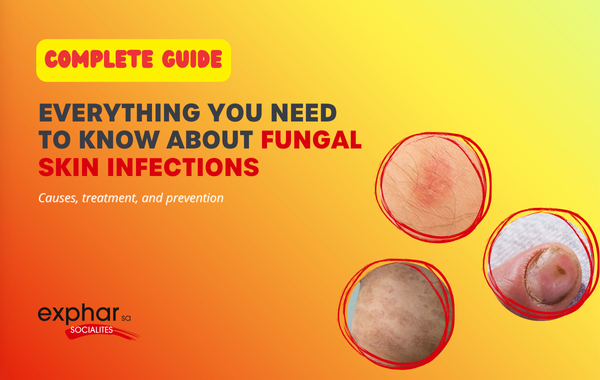Fungal skin infections, also known as cutaneous mycoses, can affect the skin, mucous membranes, nails, and scalp. Although these infections are generally mild, they can cause uncomfortable symptoms such as itching, redness, and changes in the texture of the skin and nails.
The fungi responsible for these infections are ubiquitous in our environment and normally coexist in harmony with the bacteria of our skin flora. However, various factors can disrupt this balance, promoting the development of fungal infections.
This article explores the causes, types, symptoms, and treatments of cutaneous mycoses, providing a comprehensive guide to recognizing and managing these infections.
What Are the Different Types of Fungal Infections?
Cutaneous mycoses can manifest in various ways depending on the type of fungus involved and the area of the body affected. Here is an overview of the main types of fungal infections:
- Dermatophytosis (Ringworm): Fungal infections that primarily affect the skin, hair, and nails. Scalp ringworm is common in children.
- Candidiasis: Caused by fungi of the Candida genus, it can affect the mucous membranes (oral, genital), skin, and nails.
- Onychomycosis: Nail infections that cause thickening, discoloration, and brittleness.
- Intertrigo: Infections of skin folds, often caused by moisture and heat.
- Pityriasis Versicolor: Superficial skin infections that lead to discolored or hyperpigmented patches.
What Causes Fungal Infections?
The fungi responsible for these infections are microorganisms present in the environment and the body (skin, mucous membranes, mouth, intestines, and genitals). Usually, they coexist harmoniously with local bacteria. However, changes such as increased temperature and humidity or hygiene imbalances can disrupt this harmony, allowing fungi to proliferate and become harmful.
Fungal infections can result from an imbalance of the saprophytic flora due to external causes (moisture, irritation) or internal causes (decreased immunity, diabetes, antibiotics), or from contamination through direct contact with infected people, animals, or objects (clothing, towels, floor mats, combs, toys).
Good to Know: Humid heat, excessive sweating, frequenting swimming pools, gyms, and saunas, wearing closed shoes or rubber boots, as well as certain diseases (diabetes, immune deficiency) and medications (antibiotics, corticosteroids) promote the development of cutaneous mycoses. Pregnancy and early infancy also increase the risk.
How to Recognize a Fungal Skin Infection?
Symptoms vary depending on the type of fungal infection and the affected area, but common signs include:
- Redness and inflammation
- Intense itching
- Scaly or cracked skin
- Appearance of white or discolored patches
- Thickened, discolored, and brittle nails
- Hair loss in patches (for scalp mycoses)
How to Treat a Fungal Skin Infection?
Having a fungal skin infection is never serious, but it requires treatment as it will not disappear on its own. Without treatment, there can be no cure, and the infection may spread and turn into impetigo.
The treatment of cutaneous mycoses depends on the type and location of the infection. Treatment options include:
Topical Antifungals: Creams, lotions, powders, or sprays applied directly to the affected area. They are often sufficient for mild infections.
Oral Antifungals: Used for more severe or extensive infections. They are prescribed by a doctor and must be taken over a prolonged period. For example, FLUCAZOL is frequently prescribed as it is suitable for the whole family. Available in capsules, powder, and single-dose stick packs, this treatment effectively eliminates fungal infections and prevents their recurrence. Consult your doctor for advice.
General Recommendations: Keep the affected area clean and dry, avoid tight and synthetic clothing, and use personal towels.
Conclusion
Cutaneous mycoses are common but generally mild infections caused by the overgrowth of fungi on the skin, mucous membranes, nails, and scalp. They can be favored by warm and humid conditions, certain diseases, and medical treatments.
Treatment depends on the severity and location of the infection, including topical antifungals for mild cases and oral antifungals, such as FLUCAZOL, for more severe infections. It is crucial to treat fungal infections as they do not resolve on their own. For an accurate diagnosis and appropriate treatment, consult a healthcare professional.
